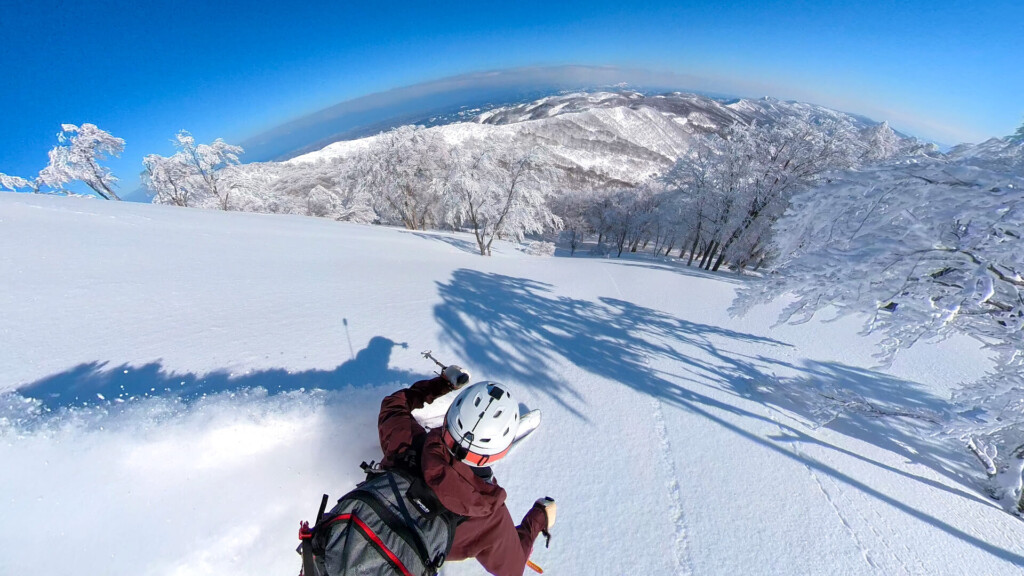
It's so much fun to take "like drone" ski footage with the 360-degree action camera Insta360 X3 [How do you shoot it? 】
Let's throw away your SLR and go on mountain skiing with the 360-degree action camera "Insta360 X3"
Since the number of people skiing (backcountry skiing) in winter mountains has increased over the past few years, I have been unable to let go of Insta360 (latest model is the Insta360 X3)
Until now, the cameras I've taken to the mountains have been Gopro, which can capture a decent amount of images as a SLR or an action camera, but I have found both of them quite inconvenient to filming in the backcountry.
Now, with this advanced Insta360 and a high-performance smartphone camera, you can not only eliminate the complaints and inconveniences of both the SLR and existing action cameras, but you can also enjoy unique images that can only be achieved with this camera. Before I knew it, I had let go of my SLR and Gopro, and I was able to get the style of having one Insta360 (and smartphone) enough, unless I had a special purpose.
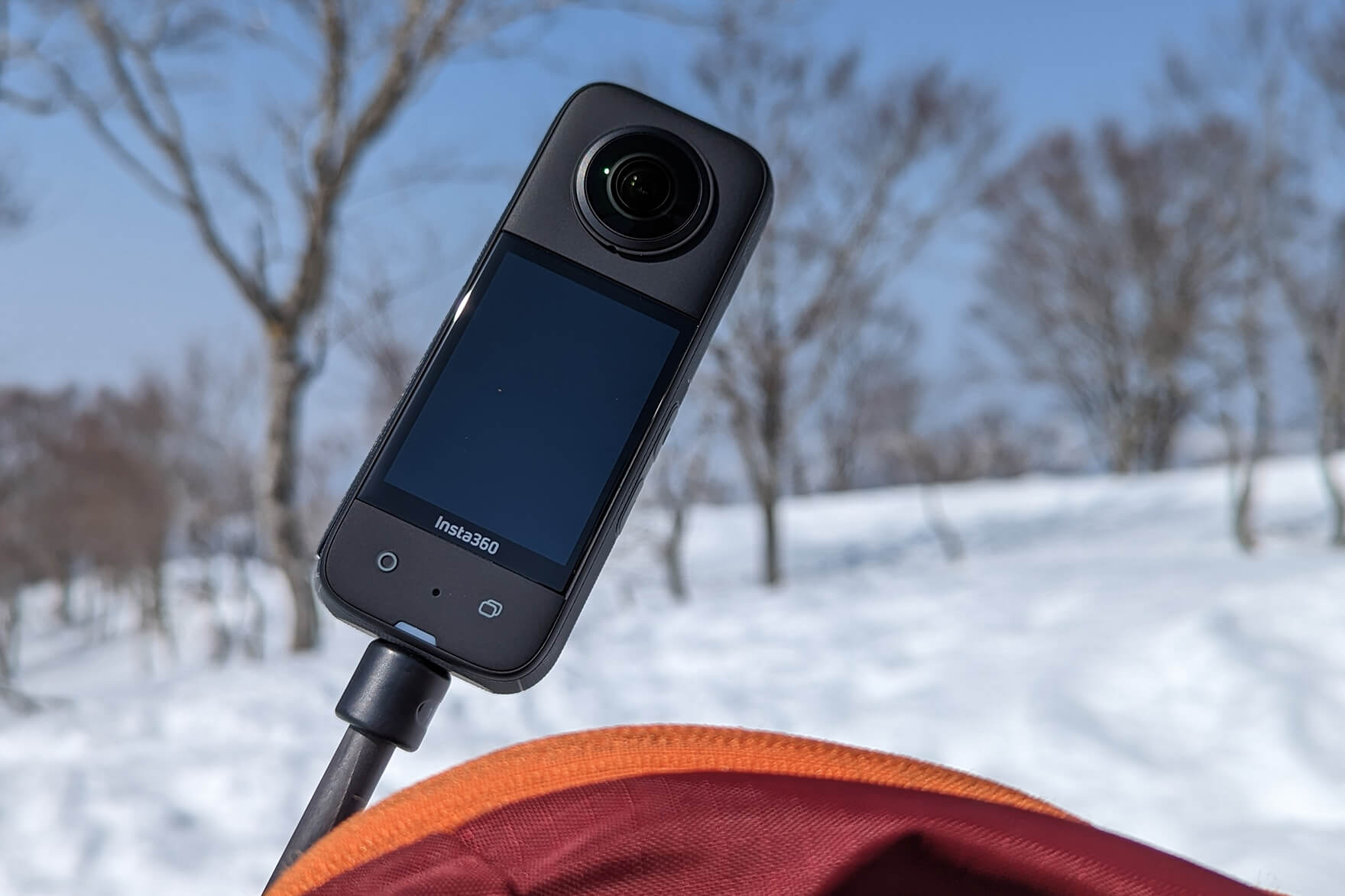
I want to shoot the best skiing video with the Insta360 X3, which allows you to shoot 360-degree videos full of immersive 360-degree videos!
the Insta360 X3 is that it is easy to shoot 360-degree videos, which are extremely realistic, which is impossible with a normal camera, but recently, with the evolution of portability, image quality and functionality, it has become possible for anyone to easily create unique images that they have not been able to capture before.
Among them, what I am particularly addicted to is the "following-up" composition, which looks like a third person taking a photo from behind. Even though I'm filming on my own, I can take pictures as if another photographer or drone was photographing myself from an altar (following the photos) (and because my hands are free, I can concentrate on the action). I've tried putting up a pattern of a tree run at Nabekurayama, which I recently took with that composition.
The video below is the vertical angle of view version posted on Instagram.
View this post on Instagram
With traditional action cameras, it was almost impossible to continue to capture a subject in a steady manner without holding a selfie stick or something with your hands in a violent movement like a ski. That's actually pretty easy to make with Insta360. However, this method of photography has not yet been generalized, so I needed my own ingenuity to establish a perfect method.
So, this time we'll be reporting on various methods that anyone can easily make "drone style (simulated photo shoot)" photography, as well as the best methods we've come to.
table of contents
- Introduction: My favorites for Insta360 X3 - What you can do with Insta360 x3
- Point 1: High image quality and image stabilization
- Point 2: You can trim the 360-degree footage you have taken into your favorite composition later.
- Point 3: A variety of shooting modes that cover almost everything you want to take with this one
- Point 4: IPX8 grade 10m waterproof, fairly strong, battery is low at low temperatures, no problem
- Point 5: You can take photos from a third-party perspective (like a drone) with an invisible selfie stick
- Until you can achieve the best drone style shooting with Insta360 x3
- The best drone style mount method for the Insta360 x3 that I finally arrived at
- summary
Introduction: My favorites for Insta360 X3 - What you can do with Insta360 x3
Point 1: High image quality and image stabilization
With basic usage, you can shoot videos up to 5.7K 30fps or 4K 60fps. Even in the "active HDR" mode, which allows you to express even more realistic brightness, it has high image quality of 5.7K 30fps. Of course, image stabilization is also available. The number of pixels in the photo is also 72 million pixels in a 360-degree photo (from here it is cropped to a specific size), which is quite sufficient.
Of course, image sensors are only 1/2 size, so the photo is still not as detailed as a SLR camera. Furthermore, it is not slightly inferior to the image processing technology of the latest smartphone cameras, so I cannot praise it for you, but I leave still images to my smartphone camera, so having this level of video recording is enough for me.
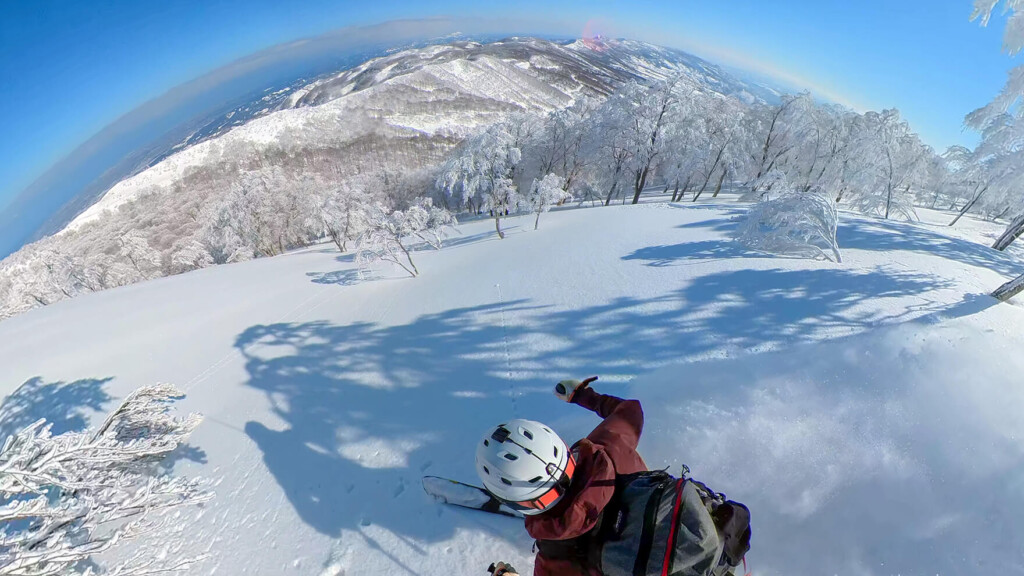
Point 2: You can trim the 360-degree footage you have taken into your favorite composition later.
Of course, with a typical action camera, videos can only be filmed at a fixed square angle of view, so it is common to check after shooting and find that they are off (and you can only choose either vertically or horizontally, either). Even when fixed to a helmet or something similar, even if you first set the angle of view, the angle may change without you realising it amidst the intense movements. In winter mountains, cameras are often set up in harsh environments where you want to leave this place as quickly as possible, so you can't keep an eye on them. The function required of a camera there is essential to being able to capture reliable images quickly, easily and with confidence.
With the Insta360, you can take 360 degrees no matter where the lens is facing, so you can just decide on the composition when editing it later. You don't have to be excited when you descend the mountain and wonder, "I wonder if you've been able to properly capture that great riding," and you can freely crop the video you've filmed, either vertically for your smartphone or horizontally for Youtube.
Of course, you will need to edit the 360-degree video later to crop (framize) it into a square video, but the hassle is subtle compared to the benefits that can be achieved, so I've now gotten used to it.
Incidentally, with the Insta360 X3, you can use the "single lens mode" as well as the "single lens mode" to capture the camera as a normal action camera. Even in this case, you can enjoy the action camera functions unique to 360-degree lenses, such as "Me Mode," which allows you to keep track of the camera angle from your own centre.
Point 3: A variety of shooting modes that cover almost everything you want to take with this one
I'm not yet able to use that many different functions, but this camera has all the functions that can be used as a general "digital camera" or "action camera" and of course, as shown below.
- 5.7K 360-degree active HDR video shooting
- 72 megapixel still photos (standard, HDR, burst, interval, starlapse mode)
- 8K time lapse video
- 360 degree live streaming
It has all the features that can be used whenever you need it on your days off, leisure, travel, or outdoor activities, so it is recommended for a wide range of outdoor enthusiasts, not just mountain skiers like you.
Point 4: IPX8 grade 10m waterproof, fairly strong, battery is low at low temperatures, no problem
If you are using it for mountain climbing or skiing all year round, it is essential to have solid durability, waterproofness, and low temperature response, but this is also quite clear. By the way, the battery also has a continuous recording time of 81 minutes, which is not a problem if used in pinpoint positions (it's best to have a spare battery just in case of winter mountains).
However, the protruding lenses, which are weak points of 360-degree cameras, must be handled in a delicate way. For this reason, adhesive lens protection covers are available as an option, but the disadvantage is that when sunlight enters, subtle irregular reflections are reflected between the lens and the image becomes dirty. For this reason, some people don't cover the image for the quality (if the lens breaks, it's clean and repaired for a fee), but in my case, it's easy to expect moss on skis or gliding through the forest and hitting the branches, so a cover is essential.

Point 5: You can take photos from a third-party perspective (like a drone) with an invisible selfie stick
This is the main topic of this article. With Insta360, when you shoot a 360-degree video with a dedicated selfie stick, the selfie stick is image processed and disappears. The boundary lines between the front and rear lenses are also processed to such a beautiful degree that you hardly notice them, resulting in a natural 360-degree video where there is no selfie stick.
It was just fun at first, and it started when I carried the camera attached to a selfie stick over my shoulder and skated it. So, the footage seems to be a perfect footage from behind me. I thought this was worthy of a little more extreme, so I became completely addicted to this trial and error.
Incidentally, this mounting method has a long selfie stick behind it, making it extremely dangerous to do it carelessly in crowded ski resorts or crowds (and it is quite noticeable). Needless to say, please be very careful about those around you and enjoy yourself at your own risk.
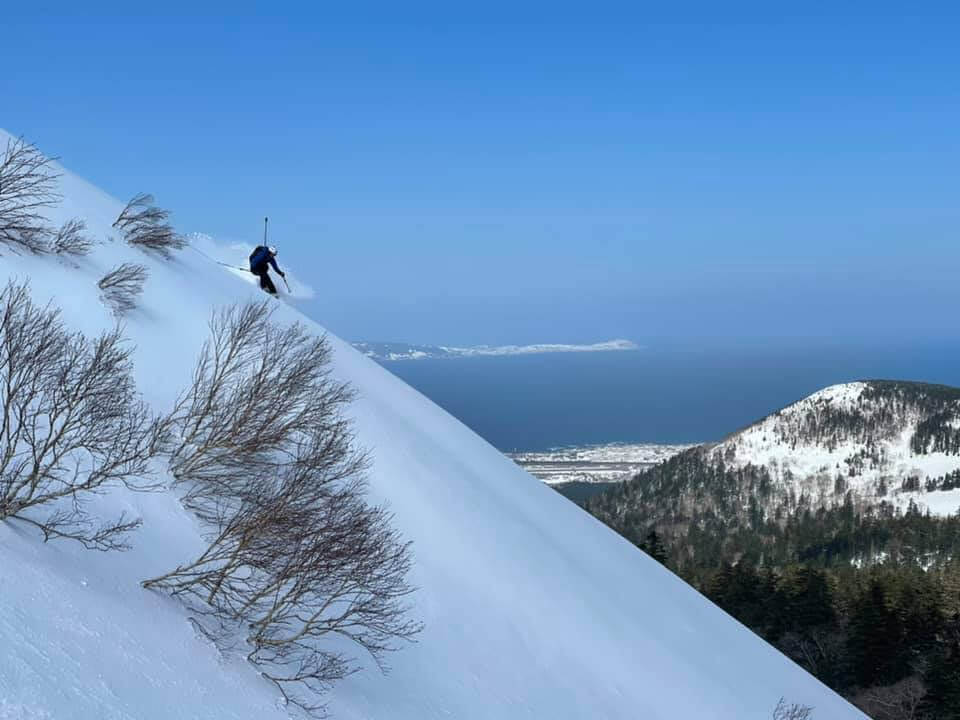
Until you can achieve the best drone style shooting with Insta360 x3
Verification No. 1: Try simply sticking it in your backpack
First of all, I tried to hold a 1.2-meter selfie stick upright on my backpack and secure it vertically.
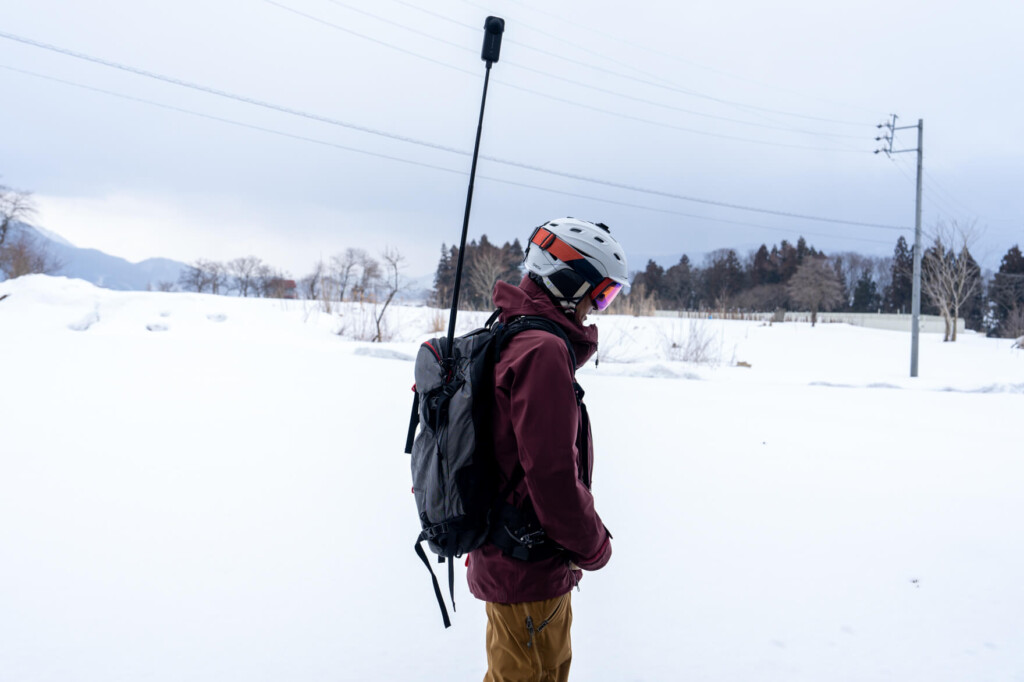
Basically, all you need is a selfie stick, and you don't need a special mount to secure it in place, but something that can be attached to the end, such as anything, such as an anchor, to prevent the camera from rotating around due to intense movements, and to prevent the selfie stick from slipping out (photo below). You also need to make efforts to prevent the mouth of your backpack from opening or loosening the strap (I use the ski strap to fix the zipper).
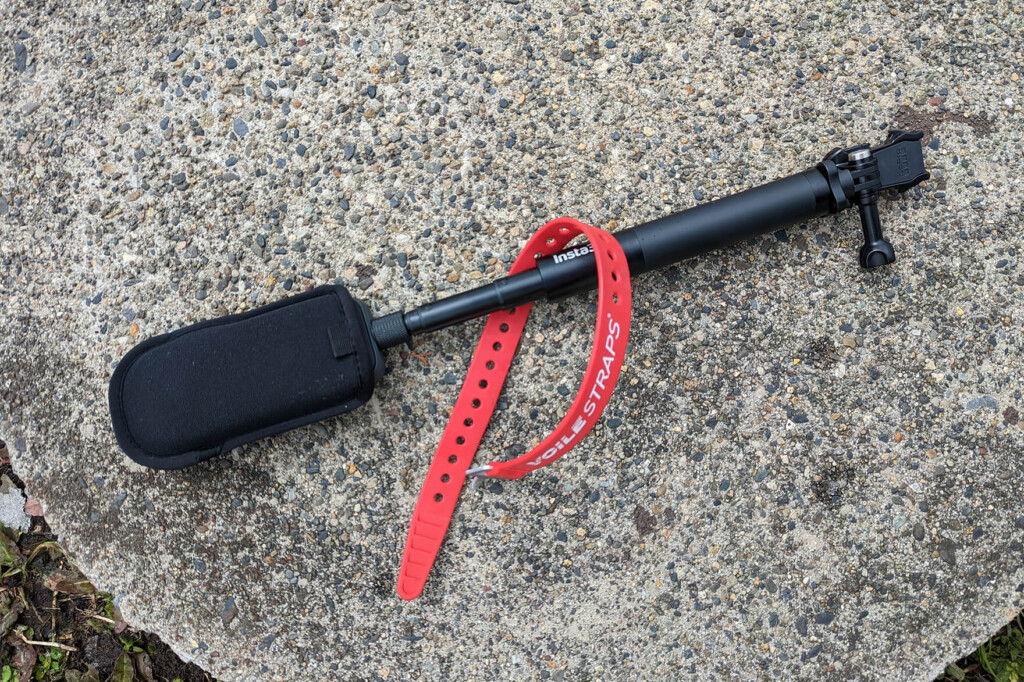
This is how I filmed the video below (I have written out two types of videos, horizontal and vertical for comparison).
A vertical video somehow manages to store the entire video, but when I turn it into a horizontal video, I hardly see myself, and the video is almost the same as when I mounted it on my head. In this case, the camera position is too high above your head, and if you try to put yourself in, you'll end up with an angle just above the ground. Even if the fixed position is placed in the side pocket instead of the main storage of the backpack, the result will be almost the same. As you can see from this, in order to get yourself and the scenery from a bird's eye view, the camera must be positioned diagonally behind and farther apart. In addition, in order to secure the camera firmly, there is also the hassle of having to compress the selfie stick with luggage and keep it fixed so that it does not move. The method is very simple and easy, so it can be done in some cases, but it is not the best way to mount it.
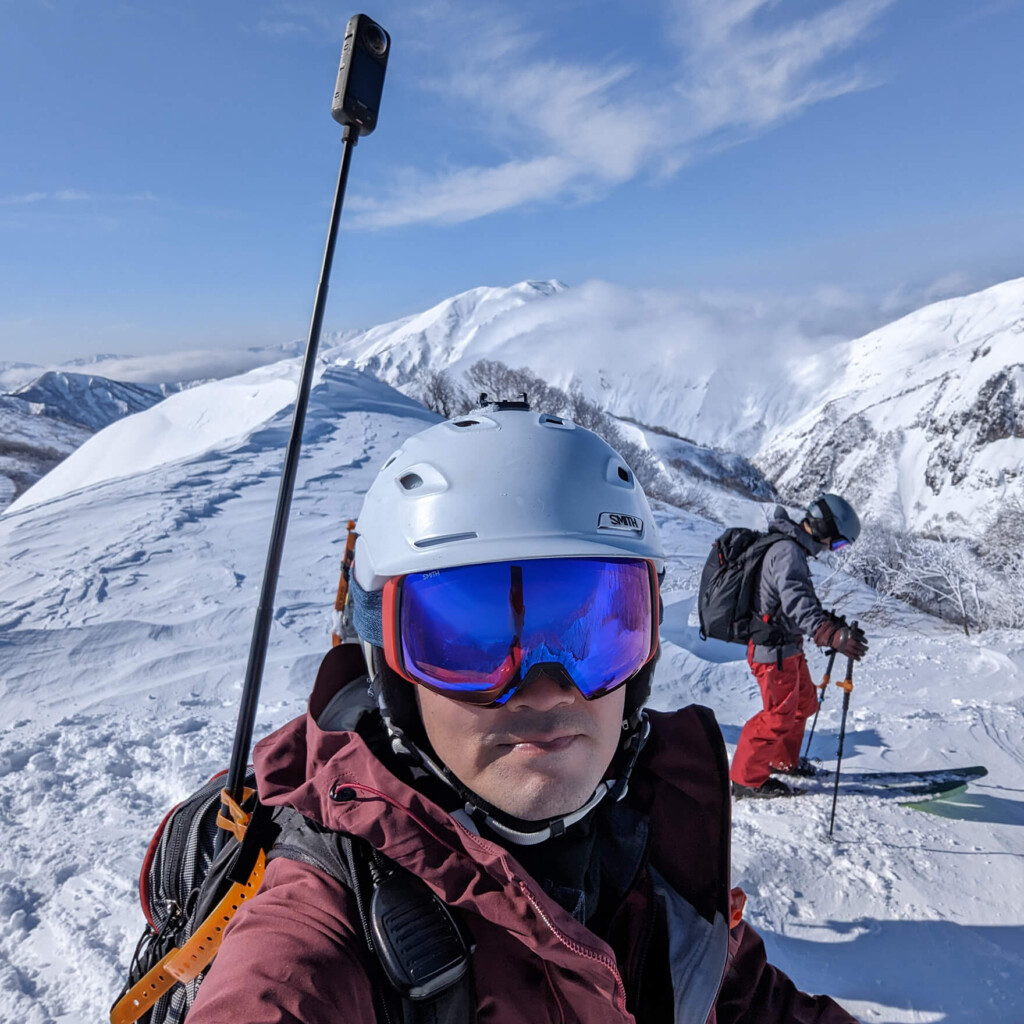
Verification No. 2: Secure it to the shoulder strap of your backpack
The next thing I tried was this shoulder strap fixation.
When I came up with the best positioning to place the camera diagonally behind me, I thought it might be on a straight line extending from the shoulder opening like a hikiko rod, so I thought of how to attach a mount to the shoulder harness and secure the selfie stick there.
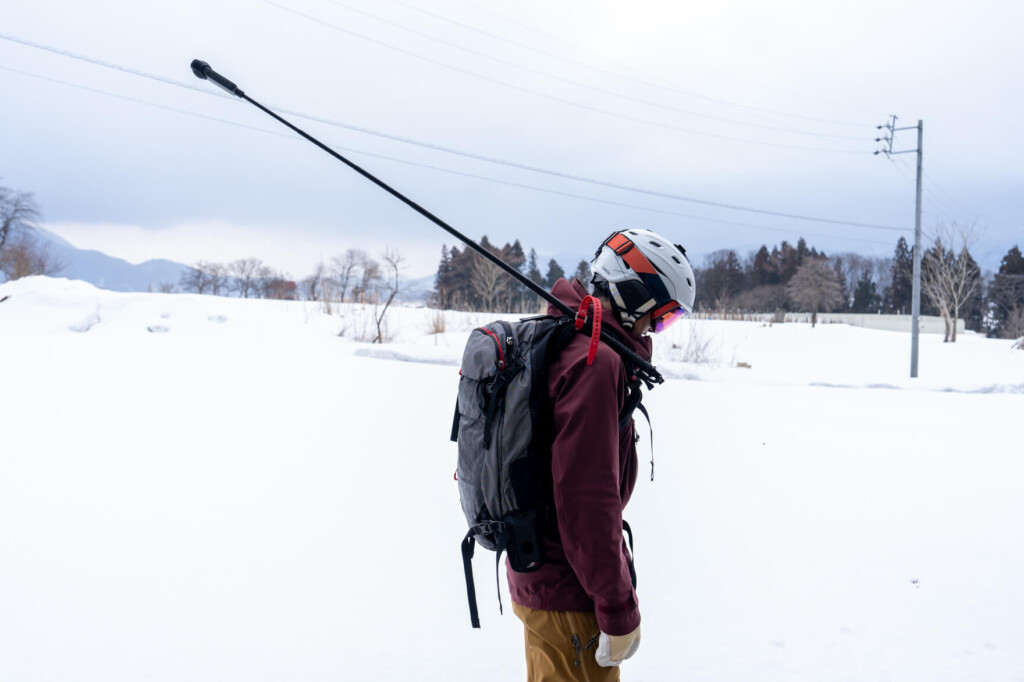
I tried it right away and it was pretty good. If it's just the video, it's closest to the ideal. Above all, as expected, the camera's angle and distance are perfect, allowing you to capture the fluffy snow surface, the mountains in front of you and the blue sky while capturing it from behind and slightly above yours. Furthermore, the camera is located not too high, giving it a sense of speed as it cuts through the wind.
Here is the mount used in this fixing method. In my case, I used the Peak Design camera holder Capture, which I used for SLR cell phones, and the POV kit, which is a mount that allows Gopro etc to be attached to it, to attach to it. This doesn't necessarily have to be the case as long as the selfie stick can be fixed to the shoulder strap. Set it around the height of the shoulder strap under the armpit, and then secure it at the side of the neck using a ski strap or something similar (photo below).
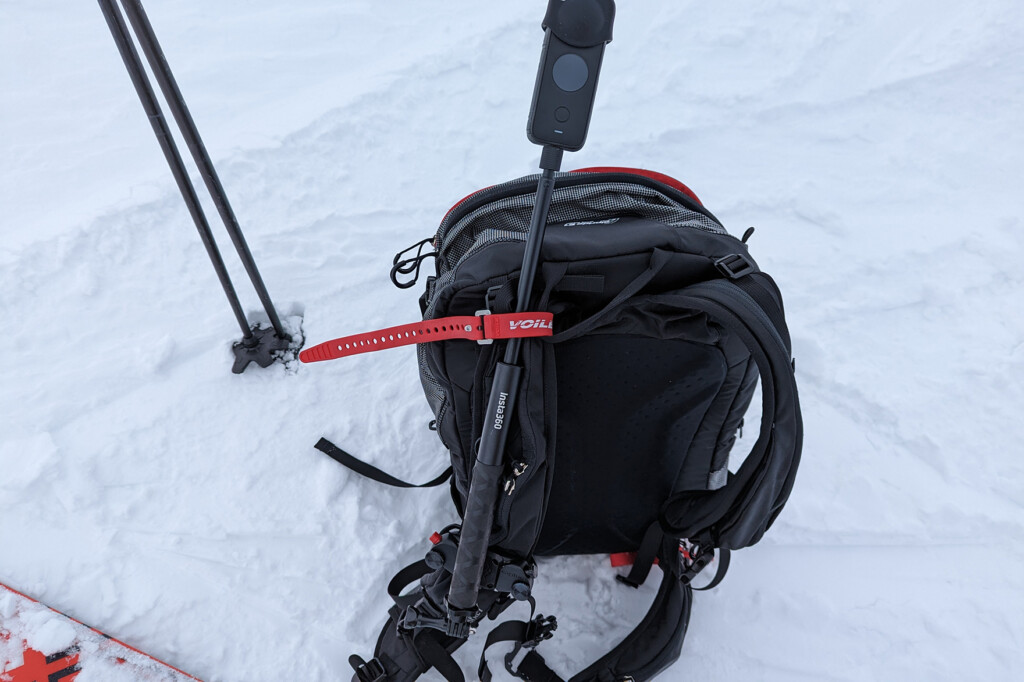
However, the problem is that although the visuals are great, there were two major problems with the fixation method. One is that the tip of the camera is fixed only around the shoulders, so the tip of the camera tends to sway and shake. Another thing is that the hard rod is firmly fixed to the shoulder strap, so it hurts a little when carried on your back. The video is great, but it's a shame. It seems to be exclusively for large slopes with pinpoint, large turns.
Verification No. 3: Try the genuine third-party backpack mount (and ski shooting set)
By the way, the Insta360 also sells mount sets called "ski photography sets" and, this season, a "third-person backpack mount" that are also available as options. Can these be used? Of course I also tried that.
First of all, the former ski shooting set is a set of a mount to secure it to a helmet, chest, or pole and a selfie stick, and in the first place, the irregular mount like this one is not considered, so this is not relevant to the theme of this time.
However, I thought that this might be good news for me, having been struggling with a lot of things for the past year, and I immediately tried it out right after its release.
The outcome was a totally huge failure.
This mount has a Velcro fastening of the belt extended from the back to the shoulder strap of the backpack, but in any case, it's quite messy to say that this fixing method is completely unstable.
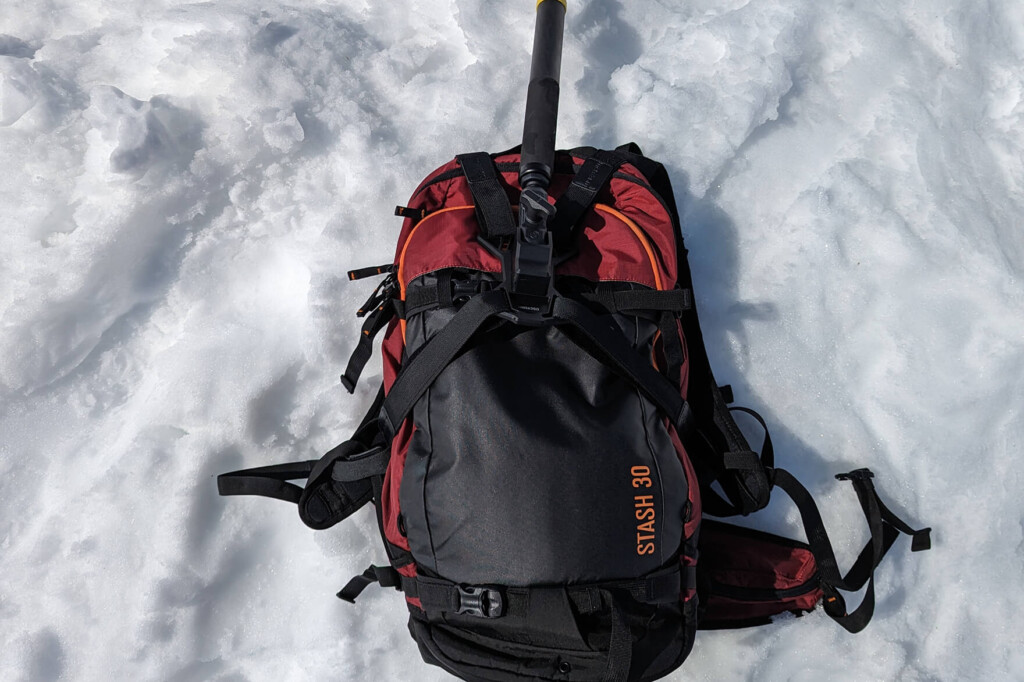
No matter how tight it is held, if a large centrifugal force is applied like a ski, the mount will quickly become slurped and slurped. The ball-shaped fixing part of the mount is also difficult to use as it becomes too tight or loose in winter mountains where temperatures are very different. Structurally, it was something that could not fit into the backpack I used. It was a shame that it was a expensive purchase.
The best drone style mount method for the Insta360 x3 that I finally arrived at
After trying out a variety of mounts and homemade fixtures, this is how I came across it. Extend the waist harness backwards through the side of the backpack.

With this method, it doesn't hurt when fixed like when it's on the shoulder, and you don't even notice it hanging from side to side. The angle was just as impressive as the previous method, and the impressive footage was captured at just the right angle.
Let's take a look at the video taken with this mount.
The angle is slightly higher than that of fixed to the shoulder strap, but with this method, I was able to put myself in the landscape and the scene in both vertical and horizontal directions, and then took a third-party gliding video with as little distortion as possible (in fact, this video was a bit of a failure, and depending on how it was fixed, it is possible to shoot from the back from a slightly lower angle). What's more, it can be fixed without hanging tightly, and thankfully, even if it is fixed, it doesn't hurt anywhere.
This method was a wristband mount for Gopro.
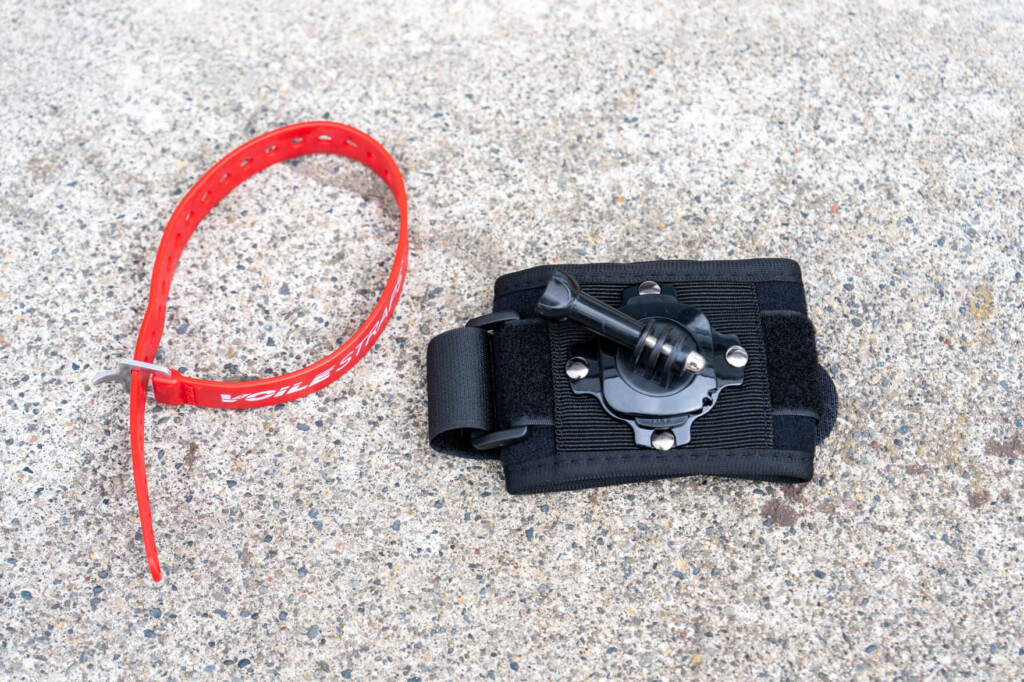
This is suitable for use in that the mount rotates 360 degrees, so you can wrap it around the waist harness and then extend it to the angle you want to stretch it out. It's a simple matter to find it, but I never thought that such a perfect tool would lie in a place like this.
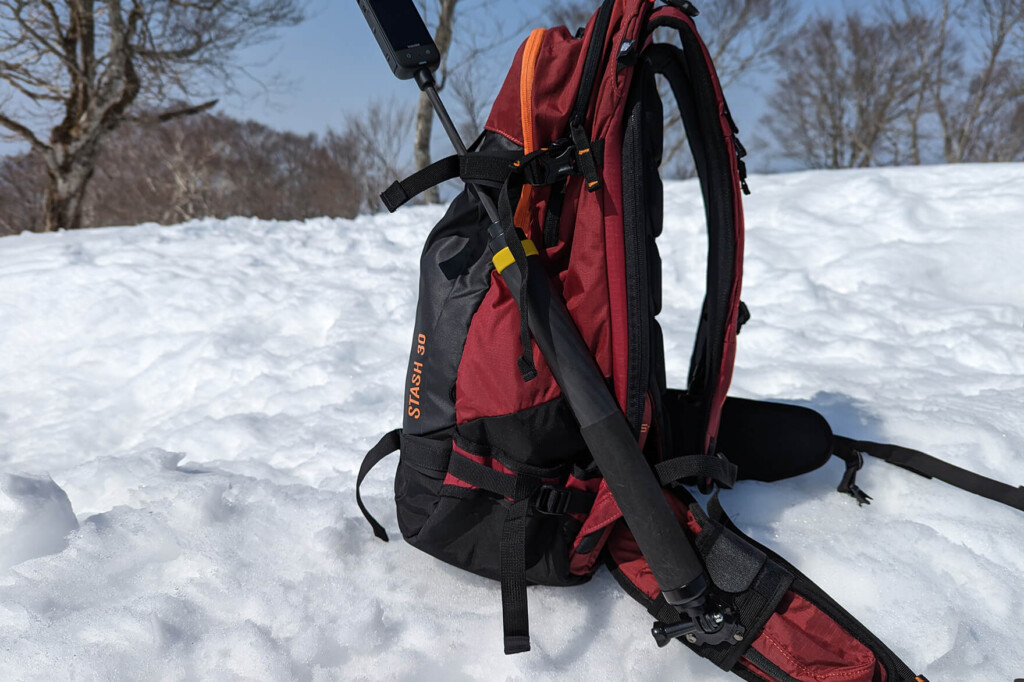
Wrap the wristband mount around the waist harness. Pass it through somewhere on the side of the backpack (the lower the lower the better). If necessary, secure it round and round with ski straps or other means to reduce hanging.
summary
This allows for the best current drone-style shooting, but we still need to verify the distance between the camera and the subject. I want to make the image as little distortion as possible, so I would like to pull the camera down to do so, but the selfie stick I am using this time is the standard size of 1.2 meters, so there is a limit. If you use this as a 3-meter long selfie stick (without stretching it to 3m), you might be able to take a bird's-eye view from a further downward perspective. In any case, the journey to the more perfect mount seems to continue.
There is no doubt that the Insta360 is a gadget with the potential to bring new surprises to many outdoor people, from casual needs to simply want to shoot 360-degree images to those who want to capture elaborate images with their own unique ideas. We hope this will be of use to as many people as possible, including extremely rare people who want to film solo skiing on the Insta360.





 I, a beginner at both action cameras and starry sky photography, took a starry sky photo and time lapse video with "Insta360 X4" [Step Explanation]
I, a beginner at both action cameras and starry sky photography, took a starry sky photo and time lapse video with "Insta360 X4" [Step Explanation] With the 8K 360-degree camera "Insta360 X4", you can enjoy mountain climbing and the outdoors [Practical Review]
With the 8K 360-degree camera "Insta360 X4", you can enjoy mountain climbing and the outdoors [Practical Review] Can the Insta360 Ace Pro, a full-scale action camera jointly developed with Leica, be used for mountain climbing or skiing? Things that caught my eye when I switched to a mountain-loving GoPro user and noticed
Can the Insta360 Ace Pro, a full-scale action camera jointly developed with Leica, be used for mountain climbing or skiing? Things that caught my eye when I switched to a mountain-loving GoPro user and noticed Four recommended mount accessories that make it even more convenient to use the Insta360 Ace Pro action camera with excellent practicality
Four recommended mount accessories that make it even more convenient to use the Insta360 Ace Pro action camera with excellent practicality